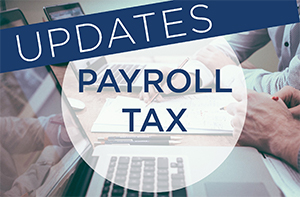PPP Flexibility Act extends payroll tax deferment, gives companies added liquidity
 Under the recently passed Paycheck Protection Program (PPP) Flexibility Act, ALL companies now have until the end of the year to defer the employer share of worker’s Social Security tax – potentially freeing up thousands more in liquidity at no extra cost.
Under the recently passed Paycheck Protection Program (PPP) Flexibility Act, ALL companies now have until the end of the year to defer the employer share of worker’s Social Security tax – potentially freeing up thousands more in liquidity at no extra cost.
Initially, businesses could only defer their 6.2 percent share of Social Security tax paid for each worker from the date the Coronavirus Aid, Relief, and Economic Security (CARES) Act became law on March 27 until they received loan forgiveness.
The change gives all companies the same Dec. 31 deadline to start paying the 6.2 percent tax again – including companies that did not get PPP loans and or those that did not receive loan forgiveness.
Businesses must pay 50 percent of the deferred tax amount by Dec. 30, 2021 and the remaining 50 percent by Dec. 31, 2022 – essentially making the deferment an interest-free loan.
Additionally, the Flexibility Act allows businesses to spend their PPP loan over 24 weeks instead of eight. During the expanded 24-week period, companies still need to follow the CARES Act guidelines on how to spend the money — paying for salary and benefits, as well as interest on mortgage obligations, rent and utilities.
While the changes bring welcome flexibility to the program, it is still imperative that businesses carefully track and document how they spend their PPP funds to ensure they receive maximum loan forgiveness.
Allowing companies to defer Social Security payroll taxes and additional changes made under the PPP Flexibility Act bolsters the original goal of the program: give businesses with 500 or fewer employees additional capital to help them stay afloat and keep workers on the payroll.
How deferring Social Security tax acts like an interest-free loan
As an example, let’s look at a business we’ll call XYZ Inc. that has a $16,130 weekly payroll, meaning it has a weekly employer share of Social Security payroll tax of $1,000 ($16,130 X .062 [employer share of Social Security tax] = $1,000).
Here is a closer look at how it works:
- The CARES Act becomes law on March 27 and XYZ starts deferring its weekly $1,000 employer share of Social Security payroll tax at the start of its next pay period on March 30.
- XYZ continues deferring its $1,000 weekly employer share of Social Security payroll tax until the end of the year, which is allowed under the CARES Act – which would equate to 40 weeks.
- At the end of 24-week period to use its PPP loan, XYZ submits paperwork to its lender detailing how it spent the money so the lender can determine loan forgiveness. The lender still has 60 days to let XYZ know how much of the loan is forgiven, but under the Flexibility Act the company can still defer its share of the Social Security payroll tax until year’s end.
- Over the 40 weeks — from March 28 until Dec. 31 – XYZ has deferred $40,002.40 in employer Social Security payroll taxes. (Total payroll expenses of $645,200 X .062 = $40,002.40)
- XYZ must pay the first half of the deferred taxes, or $20,001.20, by Dec. 30, 2021 and the second half by Dec. 31, 2022. Again, these payments are interest-free.
Before the Flexibility Act, XYZ would have only been able to defer its share of the payroll tax until its lender told the company how much of the PPP loan forgiveness it received – potentially lessening the deferral period by weeks and thousands of dollars.
For more information, visit https://www.irs.gov/newsroom/deferral-of-employment-tax-deposits-and-payments-through-december-31-2020
Bottom line
Calculating loan forgiveness and ensuring PPP money is spent correctly can get complicated, and Boyer & Ritter is available to help your business with everything from applying for a PPP loan to assisting you with the loan forgiveness application. A description of these services can be found here.
If you have questions regarding related COVID-19 laws and regulations, please refer to the resources available at www.cpabr.com.



